Table of Contents
Standard Room Sizes
When we plan to construct our dream house, we want it to have proper sunlight and ventilation and fulfil all our requirements with maximum space utilization.
To achieve this, we should know the standard sizes of various rooms and the location we will plan for our dream house.
It is essential to know the rooms’ standard sizes and locations because their proper implementation provides natural air, sunlight, and space for movement for the residents.
Today, in this article, I’m sharing the standard sizes of various rooms and their location to plan your dream home quickly.
A bungalow-type standard residential building consists of a front and rear verandah, drawing room, dining room, kitchen, store, pantry, bedroom, dressing, bathroom, water closet, office room, guest room, and garage.
According to the need and money availability, one can reduce the number of the room. The drawing room, dining room, pantry, kitchen, and store should be drawn in one row and connected to set the plan.
While bedroom, dressing room, office room, bath, and water closet should be drawn on the other side with a corridor or covered passage in between to approach the drawing-room and bedroom, etc., directly.
The following are the maximum and minimum areas for the different parts of the building.
| S.No. | Room Name | Minimum Floor Area (Square Meter) | Floor area for Ordinary Building (Square Meter) | Floor Area For Standard Building (Square Meter) |
|---|---|---|---|---|
| 1 | Drawing Room | 13.50 | Up to 20.00 | 20.00 to 28.00 |
| 2 | Dining room | 10.00 | Drawing room may be used as a Dining | 17 to 20 |
| 3 | Bed Room | 11.00 | 15.00 to 20.00 | 15.00 to 25.00 |
| 4 | Office Room | 6.50 | – | 7.00 to 9.00 |
| 5 | Guest Room | 7.00 | – | 9.00 to 10.50 |
| 6 | Kitchen | 5.50 | 7.00 to 8.50 | 7.00 to 9.00 |
| 7 | Store | 5.50 | 5.50 to 6.00 | 7.00 to 9.00 |
| 8 | Pantry | 4.5 | – | 5.50 to 7.00 |
| 9 | Dressing Room | 5.5 | – | 4.00 to 7.00 |
| 10 | Bath and W.C. | 2.8 | – | 4.50 |
| 11 | Bath | 1.8 | 2.5 to 3.50 | – |
| 12 | W.C. | 1.5 | 1.2 to 1.5 | – |
| 13 | Servant Room | 9.00 | – | 9.00 to10.00 |
| 14 | Garage | 11.00 | – | 15.00 to 18.00 |
| 15 | Box Room | 4.00 | – | 5.00 to 7.00 |
Also, Read – What is Carpet Area, Built-up Area and Super Built-up Area?
Verandah
Verandah serves as a waiting area and separates the house from the entrance. Verandah’s location should be in the south and west. If the home is east facing, it can be located the east.
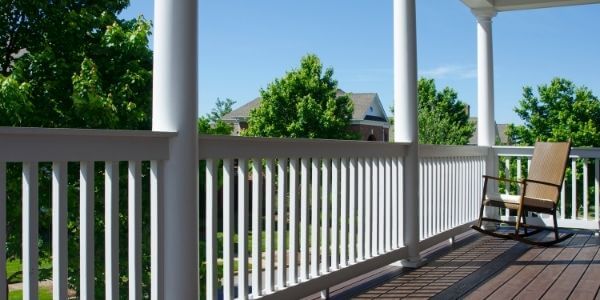
Verandah provides shade to the house’s walls during the more significant time of the day, due to which it should not have an opening height larger than 2/3 of the floor width.
Every house must have a front and rear verandah, but the rear verandah can be ignored if space doesn’t allow it.
The standard sizes of the verandah are as follows.
| Sizes | Dimension (meter) | Dimension (feet) |
|---|---|---|
| Minimum | 1.5 wide | 5′ wide |
| Average | 1.8 to 2.5 wide | 6′ to 8′ wide |
| Standard | 2.5 to 3 wide | 8′ to 10′ wide |
Foyer
A foyer is an entrance area located after the front door entrance. It connects the house’s access to the rest of the house’s interior. Some foyers give the feel of a room, while other entry areas relate to entrances.
| Sizes | Dimension (meter) | Dimension (feet) |
|---|---|---|
| Minimum | 1.83 × 1.83 | 6 × 6 |
| Average | 2.44 × 3.05 | 8 × 10 |
| Standard | 2.44 × 4.57 | 8 × 15 |
Standard Size of Living Room or Drawing
We often use the terms drawing room and living room interchangeably in the interior world, although they designate separate entities.
A living room is usually decorated with sofas, recliners, and comfortable chairs and often involves a media unit with a TV.
The drawing-room is a more social space. The decoration is managed simply and manages to be mainly operative.
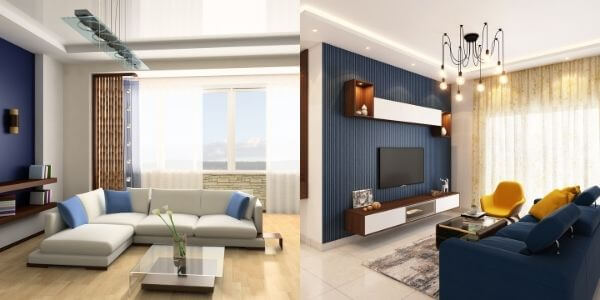
The drawing and living room is the primary and welcoming area for receiving friends and guests, and family members to sit.
Sometimes it also serves as a dining space and hall for special occasions and different activities.
Generally, it is the biggest room of the house, and its location should be in the middle of the house so that it acts as a connecting path for the front veranda, dining space, and other rooms. The size of the drawing-room depends upon the furniture types to be used.
The standard sizes of the Drawing or Living Room are as follows.
| Sizes | Dimension(meter) | Dimension(feet) |
|---|---|---|
| Minimum | 3.6 x 3.6 | 12′ x 12′ |
| Average | 3.6 x 5.5 | 12′ x 18′ |
| Standard | 4.5 x 6.1 | 16′ x 20′ |
Also, Read – 8 – Types of Stairs, Flight of Stairs
Standard Bedroom Size
Bedrooms are the essential rooms of the house where we spend our significant time, and Its location should be such that the house provides ventilation and sunlight in the morning without losing privacy.
They should have one outer wall that locates the window and provide ventilation. The location of the bedroom should be on the side of the prevailing wind direction to avoid the collection of warm air.
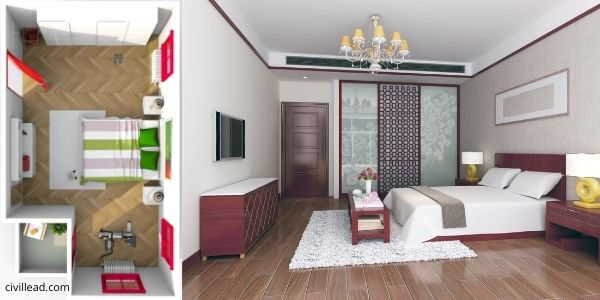
Bedrooms have furniture like beds, wardrobes, and study tables, but beds and wardrobes are sufficient for a standard-sized bedroom.
The standard sizes of the Bedroom are as follows.
| Size | Dimension (meter) | Dimension in (feet) |
|---|---|---|
| Minimum | 3.0 x 3.0 | 10′ x 10′ |
| Average | 3.6 x 4.3 | 12′ x 14′ |
| Standard | 4.8 x 5.5 | 16′ x 18′ |
Standard Size of Dressing Room
It is a small used for dressing in and soring clothes. It should be attached to the bedroom. The standard sizes of the dressing room are as follows.
| Sizes | Dimension (meter) | Dimension (feet) |
|---|---|---|
| Minimum | 2.5 x 2.1 | 8′ x 7′ |
| Average | 3.0 x 2.1 | 10′ x 7′ |
| Standard | 3.0 x 2.5 | 10′ x 8′ |
Also, Read – Difference Between Ceramic Tiles and Vitrified Tiles
Standard Size of Kitchen
The kitchen is the most operative area in an Indian house. Mostly, it is merged with the dining area, and most of the time, the kitchen and dining area are integrated with the living room to make it look more spacious and lavish.
The kitchen’s location should be in the rear corner of the house, but the SE corner is the best. It should connect with the dining room and should contain one outside approach.
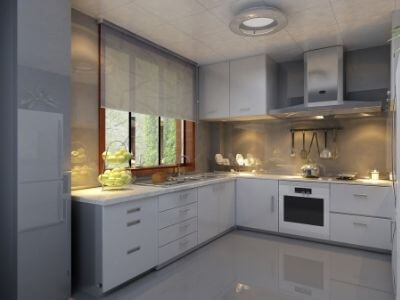
Its location should be such that sunlight should arrive in the morning times.
For proper ventilation, it should have a window and contain a chimney for the escape of smoke. The minimum space for the window should be 15% of the floor area.
The Standard Sizes of the Kitchen are as follows.
| Size | Dimension (meter) | Dimension in (feet) |
|---|---|---|
| Minimum | 2.74 x 2.13 | 9′ x 7′ |
| Average | 2.74 x 3.0 | 9′ x 10′ |
| Standard | 3.65 x 3.0 | 12′ x 10′ |
Standard Size of Dining Room
Commonly, the dining room’s location should be near the kitchen and in the rear of the drawing or living room.
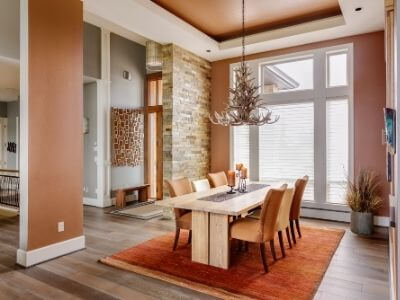
The drawing-room is connected with the dining room to have ample space for special occasions in modern houses. It is kept separate for orthodox families.
The Standard sizes of the Dining room are as follows.
| Sizes | Dimension (meter) | Dimension (feet) |
|---|---|---|
| Minimum | 3.0 x 3.0 | 10′ x 10′ |
| Average | 3.65 x 3.0 | 12′ x 10′ |
| Standard | 4.3 x 4.9 | 14′ x 16′ |
Also, Read – 9 Difference Between English Bond and Flemish Bond
Standard Size of Pantry
It is a small area located adjacent to the dining room to keep crockery, cutlery, and food. It must have enough numbers of cupboards. For a typical house, the kitchen fulfills the need of the pantry.
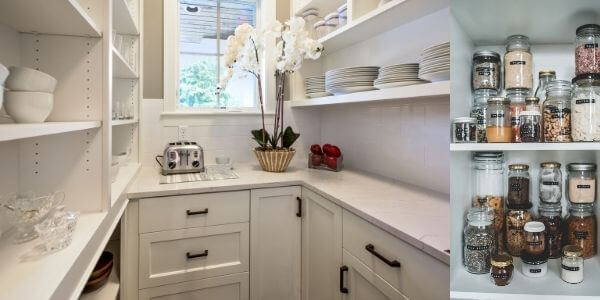
The Standard Sizes of the pantry are as follows.
| Sizes | Dimension (meter) | Dimension (feet) |
|---|---|---|
| Minimum | 1.8 x 2.5 | 6′ x 8′ |
| Average | 2.5 x 2.5 | 8′ x 8′ |
| Standard | 2.5 x 3.0 | 8′ x 10′ |
Standard Size of Store Room
The location of the storeroom should be near the kitchen and should contain enough number storage units. The standard sizes of the storeroom are as follows.
| Sizes | Dimension (meter) | Dimension (Feet) |
|---|---|---|
| Minimum | 2.7 x 3.0 | 9′ x 7′ |
| Average | 2.7 x 3.0 | 9′ x 10′ |
| Standard | 3.65 x 3.0 | 12′ x 10′ |
Standard Size of Toilet and Bathroom
Nowadays, it is common practice to provide an attached bathroom and WC with each bedroom.
Mainly bathrooms and toilets are provided commonly in a single space with separation of the wet area and dry area.

The location of the WC should be on the external wall to have proper drainage, and its distance from the sidewall should be350 mm. Usually, two windows are given, one for the ventilator and another for natural light.
The height of the ventilator should be 2000mm, and the height of the 2nd window should be 1500 mm, covered with frosted glass to allow light without losing privacy.
Ceiling height is often maintained low (2100mm or 7ft) to use the upper space for a loft tank.
The standard sizes of the bathroom with a water closet are as follows.
| Sizes | Dimension (meter) | Dimension (feet) |
|---|---|---|
| Minimum | 1.5 x 2.1 | 5′ x 6′ |
| Average | 2.1 x 2.13 | 6′ x 7′ |
| Standard | 2.5 x 2.13 | 8′ x 7′ |
Also, Read – What is WPC Boards? – Advantages, Disadvantages, Uses
Standard Size of Guest Room
A guest room should have enough light and ventilation. The guest room location should be on one side of the house, usually at the side of the drawing-room.
The guest should not have a connection from the inside of the house and have a separate toilet.
The standard sizes of guest rooms are as follows.
| Sizes | Dimension (meter) | Dimension (feet) |
|---|---|---|
| Minimum | 2.6 x 2.74 | 8’6″ x 9′ |
| Average | 3.0 x 2.74 | 10′ x 9′ |
| Standard | 3.0 x 3.65 | 10′ x 12′ |
Standard Size of Office room
The location of the office room should be on the one side of the front verandah and separate from other rooms. Many times the office room is also used as a guest room.
The standard sizes of office rooms are as follows.
| Sizes | Dimension (meter) | Dimension (feet) |
|---|---|---|
| Minimum | 2.13 x 3.00 | 7′ x 10′ |
| Average | 2.50 x 3.00 | 8′ x 10′ |
| Standard | 3.00 x 3.00 | 10′ x 10′ |
Standard Size of Servant Room
The location of the servant room or servant quarter should be toward the southeast or northeast area of the house.
The standard sizes of servant rooms are as follows.
| Sizes | Dimension (meter) | Dimension (feet) |
|---|---|---|
| Minimum | 2.74 x 3.00 | 9′ x 10′ |
| Average | 3.00 x 3.00 | 10′ x 10′ |
| Standard | 3.65 x 3.00 | 12′ x 10′ |
Also, Read – 10 Best Tiles Companies In India
Standard Size of Garage
For safe driving and good car health and to keep it safe, we need to park it in the parking or garage. The car parking or garage location should be in the northwest (park in north or east-facing), and the second option is southeast.
The standard sizes of the garage are as follows.
| Sizes | Dimension (meter) | Dimension (feet) |
|---|---|---|
| Minimum | 2.75 x 4.26 | 9′ x 14′ |
| Average | 3.00 x 4.57 | 10′ x 15′ |
| Standard | 4.2 x 6.1 | 14′ x 20′ |
Minimum Height of Rooms
Height of main room = 3.50 meters or 11 feet 6 inches.
Height of Kitchen, store, and Bath = 2.07 meters or 7 feet.
Height of Servant room = 2.5 meters or 8 feet 3 inches.
Standard Size of Boundry Wall
The boundary wall requirements are as follows.
The maximum height of the boundary wall should be 1.5 meters above the front road centerline.
If the top 0.9 meters the authority approves an open type of construction design, a boundary wall up to the height of 2.4 meters may be allowed.
For the corner plot, boundary/compound wall height is restricted to a height of 0.75 meters up to a length of 10 meters on a side and front intersection.
If the authority approves an open type of construction design(by railing), balance height may be provided for the boundary wall.
Final Words
I hope now you know the standard room sizes and their location that makes space operative. It may vary from area to area and site conditions. You can take experts’ advice or hire them to design your dream home.
The different design approaches and creativity can make any design possible in the minimum area by using it to its fullest.
Also, Read
What Does BHK Mean? BHK Full Form
What is Pointing? – Types of Pointing, Purpose, Method
House construction Cost Calculator Excel Sheet
10 Best Cement Companies In India 2021
Difference Between OPC and PPC Cement
Grade of Cement – Difference Between 33,43 and 53 Grade Cement
Difference Between Plinth Level, Sill Level and Lintel Level
What is Plinth Beam? – Plinth Protection, Difference Between plinth Beam and Tie Beam